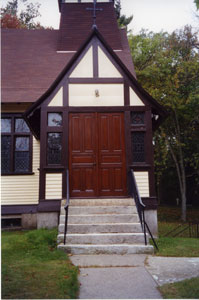
News & announcements
Saving your history
Early accounts
Maps
Nearby towns
People
Churches
Schools
Municipal
Organizations
Businesses
The mines
Transportation
Streets
Buildings
Entertainment
Celebrations
Sports
Ethnic groups
Drifton churches
What's on this page:
- St. James Episcopal Church
- St. Ann’s Church
- Welsh Baptist congregation
- Eckley churches
- St. James Chapel, Freeland
- St. Ann’s, Woodside, later in Freeland
- Zion Welsh Baptist Church
At top left: St. James Episcopal Church, Drifton
St. James Episcopal Church, Drifton
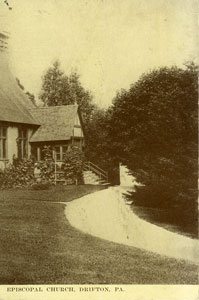
From H. C. Bradsby’s History of Luzerne County …, 1893:
“St. James Protestant Episcopal church, Eckley; organized 1858; church built 1858. Rectors: Rev. James Walker, 1871-5; A. H. Boyle, 1875-6; John Inland, 1876-92. After the formation of St. James church, Drifton, this point was being much reduced in numbers and means.”
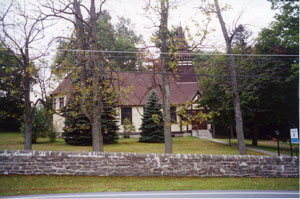 Text
from
brochure: Historical St. James
Episcopal Church, “The
Friendly Church”
Text
from
brochure: Historical St. James
Episcopal Church, “The
Friendly Church”The history of St. James is entwined with the early industrial (coal mining and railroading) development of the area. A famous founder of St. James, Mrs. Sophia G. Coxe, also was involved and contributed heavily to the welfare and happiness of many local residents and their descendents.
The first Episcopal service on the North Side was held in 1855 in the Old Eckley schoolhouse by the Rev. Peter Russel [or Russell?], then rector of St. Mark’s in Mauch Chunk (Jim Thorpe).
In 1858, a group led by A. L. Foster, coal land owner, decided to form a parish. Immediate action was taken and a building was consecrated in 1859 and stood until 1937 in Eckley.
Previous to a church having been built in Drifton, members of the Coxe family had initiated a church school held in the hotel and schoolhouse.
St. James was originally a mission station under the wing of St. James, Eckley. In 1864, the first of the famous Christmas parties was held. In 1872-73 a “comfortable and commodious building” was erected at Drifton for the use of the Sunday school.
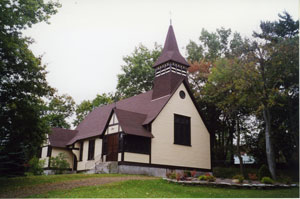 The
cornerstone of the St. James in Drifton was laid in 1883 and the
present beautiful church – inspired by St. James, Philadelphia – was
completed in 1884 at a cost of $10,000.
The
cornerstone of the St. James in Drifton was laid in 1883 and the
present beautiful church – inspired by St. James, Philadelphia – was
completed in 1884 at a cost of $10,000. This was a missionary time, by 1887 a chapel was erected in Freeland at a cost of $2,300. Also, the unusual mosaic tile floor of St. James, was installed in 1887 and 1888. It was worth $1,500 at the time but is priceless today.
St. James was constructed before electricity was utilized in building; therefore, the carpenters used hand tools and muscle power to build the new church. The foundation was formed out of local stone; wood came from pine trees found plentiful in the area. The lights used in 1893 were converted to electricity from gas, turning them downward from the original upright position. The ceiling is ingenious. Chains and pulleys enable the opening of vents to release collected heat up and out the bell tower.
The first organ was a Mueller organ from Allentown.
The grounds remain beautiful today, reminiscent of an English churchyard.
St. James is located on State Route 940 in Drifton, 1.5 miles from Freeland and 8 miles from Hazleton.
The chapel in Freeland:
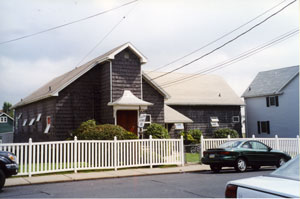 As noted above,
in 1887 St. James Chapel was established in Freeland as
a mission of the Drifton church. Many years later in 1973 the chapel
was deconsecrated and converted to apartments.
As noted above,
in 1887 St. James Chapel was established in Freeland as
a mission of the Drifton church. Many years later in 1973 the chapel
was deconsecrated and converted to apartments.St. Ann's Roman Catholic Church, Drifton/Woodside
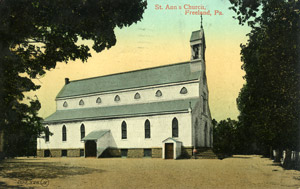 St. Ann's Church in
Woodside was originally a mission of Immaculate
Conception Church in Eckley. Built in the 1870s, the Woodside church
became a thriving parish that included a school and convent, as well as
a cemetery. St. Ann’s and Immaculate Conception in Eckley were the only
Catholic churches in the Freeland area until the founding of St.
Casimir’s in 1886, serving Catholics from various nationalities until
additional churches could be founded to serve the needs of various
ethnic groups. By 1902, changing demographics led to St. Ann’s Church
in Woodside being upgraded from a mission of the Eckley church to a
full parish, and the Eckley church was downgraded to mission status.
Rev. Falihee moved to the Woodside parish in 1902.
St. Ann's Church in
Woodside was originally a mission of Immaculate
Conception Church in Eckley. Built in the 1870s, the Woodside church
became a thriving parish that included a school and convent, as well as
a cemetery. St. Ann’s and Immaculate Conception in Eckley were the only
Catholic churches in the Freeland area until the founding of St.
Casimir’s in 1886, serving Catholics from various nationalities until
additional churches could be founded to serve the needs of various
ethnic groups. By 1902, changing demographics led to St. Ann’s Church
in Woodside being upgraded from a mission of the Eckley church to a
full parish, and the Eckley church was downgraded to mission status.
Rev. Falihee moved to the Woodside parish in 1902. This timeline information is pulled from a Standard-Speaker article dated October 14, 1987:
1869/1870? - Rev. Michael J. Fallihee became pastor of Immaculate Conception Church in Eckley, of which Woodside was a mission. The assistant pastor was Rev. McNally. Mass was originally celebrated in the old Foster Township School (Woodside School).
1871 - Cornerstone of St. Ann's in Woodside laid by Bishop William O'Hara
1874 – St. Ann’s Church dedicated by Bishop O'Hara
1883 - Excavation for convent and school at Woodside begin
1884 - Convent and school buildings dedicated
1886 - School opens, taught by Sisters of Mercy
In the early 1920s a new St. Ann's Church was built at 820 Centre Street in Freeland, again due to shifting populations, and a few years later the Woodside church was demolished. The new church was never completed above the ground level, and so the church interior was at the basement level. A brand new church was built on the same site in 1967 and it still stands today, although now it houses a new parish, Our Lady of the Immaculate Conception, comprising the four historical Roman Catholic parishes of Freeland: St. Ann's, St. Anthony's, St. Casimir's and St. John Nepomucene.
Welsh Baptist congregation of Drifton
An October 4, 1944 local news article headlined “Freeland Presbyterian Church 50 Years Old” includes a reference to two new members joining the church in 1895 from the Welsh Congregational Church of Drifton.
From Charlie Stumpf’s notes: Around 1886 a group of parishioners separated from the Welsh Baptist church at Drifton. They began to conduct worship services in Lindsay's Hall in Freeland with a group of 17 menbers, 14 of which were females.
[Was there a Welsh Baptist or Congregational Church in Drifton, and if so, where was it? Aside from those two mentions quoted above, I only have the following in my notes about Zion: “As early as 1890, there was a group of Welsh Baptists in Freeland who were meeting in the Woodside schoolhouse. Preachers who spoke at the Upper Lehigh Welsh Baptist church would also tack on an additional service at the Woodside school.” It’s my understanding that a number of these people went on to found Zion Welsh Baptist Church on Fern Street, which was later sold to the St Anthony’s congregation. – CT]
I’m grateful to Charlie Stumpf for his research on local churches.